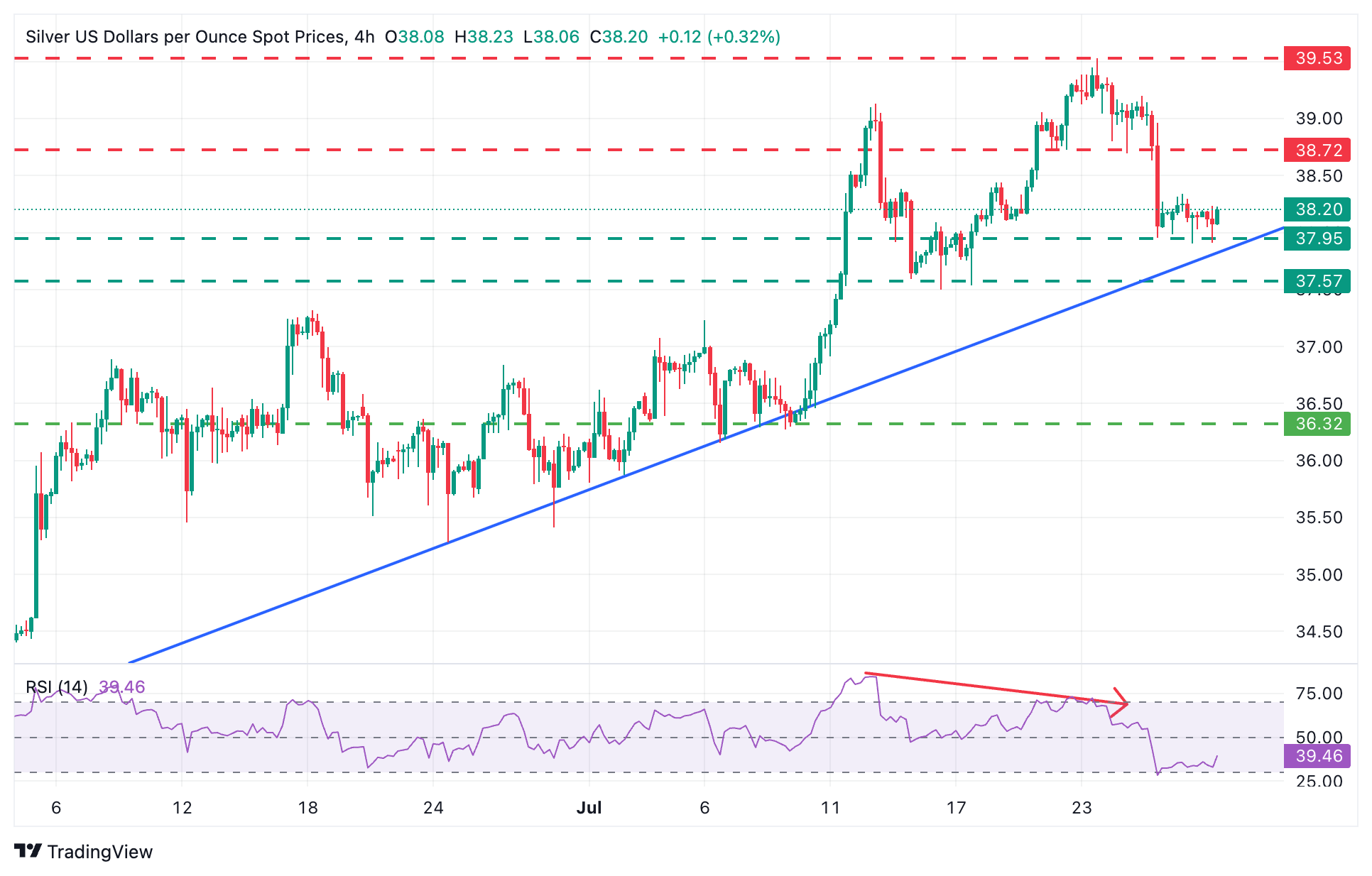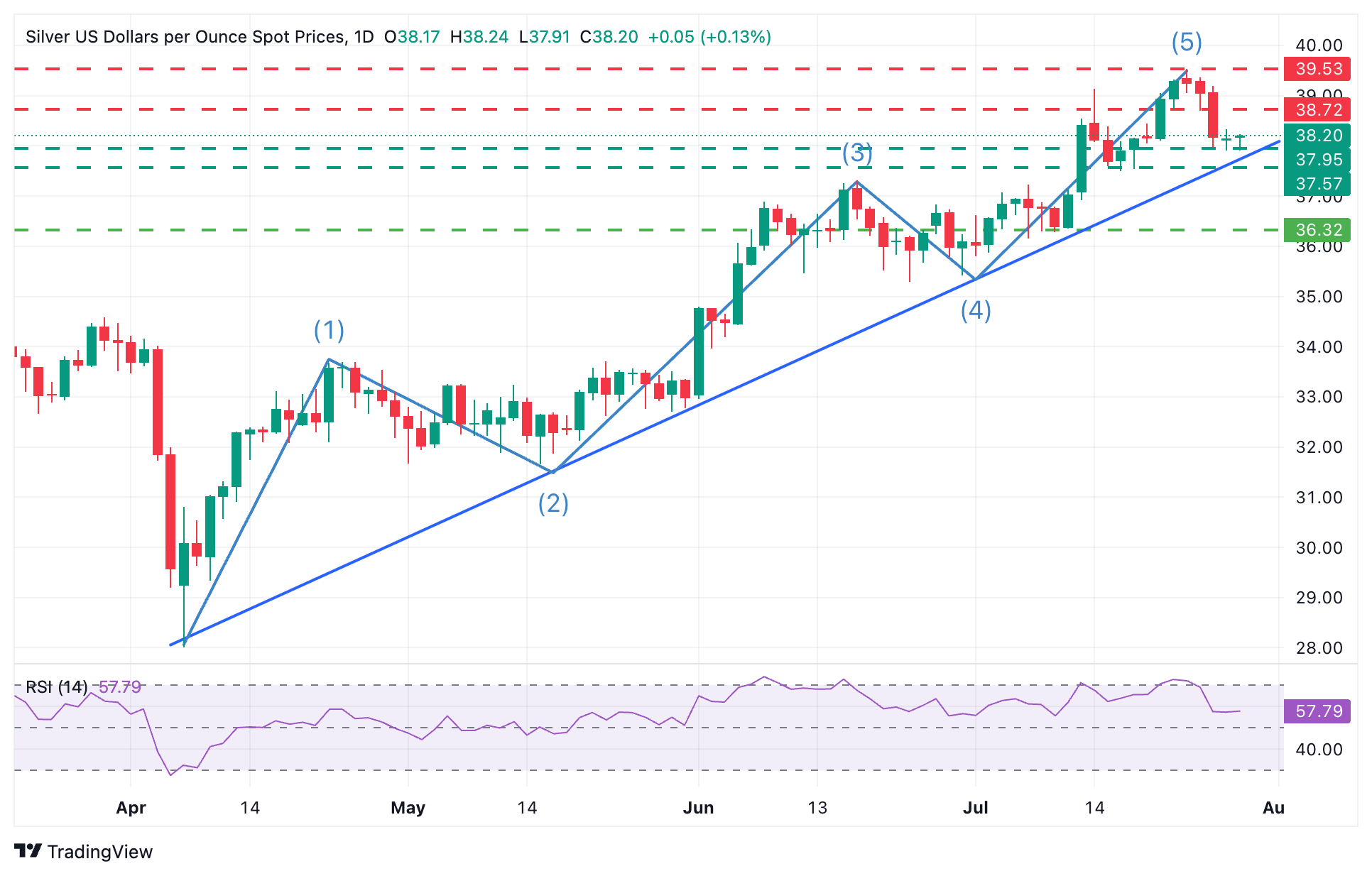Silver Price Forecast: XAG/USD approaches a key support below $38.00
- Silver consolidates losses as the US Dollar appreciates following US trade deals.
- Investors are wary of selling US Dollars ahead of key US data and the Fed's monetary policy decision.
- XAG/USD has a key support area between $37.55 and $37.85.
Silver (XAG/USD) is hovering above the $38.00 area for the second consecutive day, consolidating losses after a significant reversal at the end of last week, as strong US macroeconomic data curbed hopes of Fed cuts and boosted support to the US Dollar.
The precious metal is practically flat on Tuesday’s daily chart, with the US Dollar clinging to gains ahead of a string of key US macroeconomic events, namely the Q2 US Gross Domestic Product and, above all, the Federal Reserve’s monetary policy decision, both due on Wednesday.
Technical analysis: A mid-term support trendline lies at $37.85

The technical picture shows the XAG/USD correcting lower after an extended rally from April lows, anticipated by the bearish divergence observed in the 4-hour charts and confirmed by Friday’s impulsive reaction from the $39.20 area.
The pair is now hesitating right above the July 29 low at $38.00 with technical indicators pointing lower. The 4-hour RSI is close but not yet at oversold levels, which suggests that a further downtrend is likely, and the US Dollar continues to head higher.

Further depreciation would face converging support lines at the ascending trendline from early April lows, now around $37.85, ahead of the July 15, 16, and 17 lows near $37.55. A successful breach of these levels would confirm that the pair completed a 5-wave (Elliott Wave bullish count and is on track to an A-B-C correction.
On the upside, the pair remains capped below Monday’s high, at $38.35, ahead of the July 24 low, at $38.75, and the $39.55 long-term high reached last week.
Silver FAQs
Silver is a precious metal highly traded among investors. It has been historically used as a store of value and a medium of exchange. Although less popular than Gold, traders may turn to Silver to diversify their investment portfolio, for its intrinsic value or as a potential hedge during high-inflation periods. Investors can buy physical Silver, in coins or in bars, or trade it through vehicles such as Exchange Traded Funds, which track its price on international markets.
Silver prices can move due to a wide range of factors. Geopolitical instability or fears of a deep recession can make Silver price escalate due to its safe-haven status, although to a lesser extent than Gold's. As a yieldless asset, Silver tends to rise with lower interest rates. Its moves also depend on how the US Dollar (USD) behaves as the asset is priced in dollars (XAG/USD). A strong Dollar tends to keep the price of Silver at bay, whereas a weaker Dollar is likely to propel prices up. Other factors such as investment demand, mining supply – Silver is much more abundant than Gold – and recycling rates can also affect prices.
Silver is widely used in industry, particularly in sectors such as electronics or solar energy, as it has one of the highest electric conductivity of all metals – more than Copper and Gold. A surge in demand can increase prices, while a decline tends to lower them. Dynamics in the US, Chinese and Indian economies can also contribute to price swings: for the US and particularly China, their big industrial sectors use Silver in various processes; in India, consumers’ demand for the precious metal for jewellery also plays a key role in setting prices.
Silver prices tend to follow Gold's moves. When Gold prices rise, Silver typically follows suit, as their status as safe-haven assets is similar. The Gold/Silver ratio, which shows the number of ounces of Silver needed to equal the value of one ounce of Gold, may help to determine the relative valuation between both metals. Some investors may consider a high ratio as an indicator that Silver is undervalued, or Gold is overvalued. On the contrary, a low ratio might suggest that Gold is undervalued relative to Silver.

